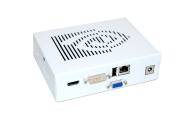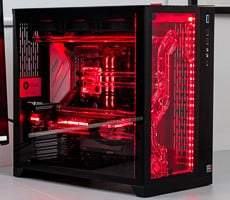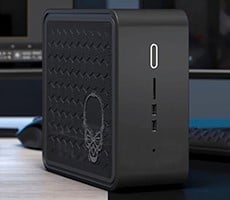NVIDIA's Ion SFF platform definitely packs a lot of functionality into a very small footprint. Pictured here below is the Ion reference motherboard, sans its I/O expansion daughter card, sitting next to a full sized desktop motherboard. Though the desktop board, when fully configured, offers a lot more muscle with a discrete graphics card and the like, it's pretty impressive to note that the Ion board essentially offers much of the same basic functionality, in a tiny fraction of the real estate.
 NVIDIA Ion relative to standard sized motherboard - Pico ITX - The Big Tiny
NVIDIA Ion relative to standard sized motherboard - Pico ITX - The Big Tiny
The NVIDIA Ion box we'll be putting through its paces in the pages ahead, is a standard reference design that is built with the intent of bringing out all of the primary functionality of the product for demonstration and testing purposes only. It's not designed with a ton of flare as a result, however, and this small black box (ours test system actually came in pure white), with the exception of its custom cut NVIDIA logo ventilation slots, only impresses with its diminutive casing which is a little larger than a standard 3"x5" index card.


 Click for high res images...
Click for high res images...


Interestingly, as is plain to see in the above motherboard shots, Ion's GeForce 9400M MCP actually dwarfs the Intel Atom 230 processor pictured here, which is the smaller of the two large chips on the right side of the board. We should note, however, that the Ion unit we tested was powered by a dual-core Atom 330 processor. With 16 graphics cores, a DDR2/3 memory controller and a whole lot of control logic and I/O functionality like PCI Express links, USB and SATA, it's no wonder either. Cooling these two chips is a single active fansink assembly that, under normal operation, frankly was a bit louder than we would have liked, clearly audible over the low hush of our 50" plasma TV in our test area. That said, the Iittle fellow wasn't so loud that it became a distraction in any significant way.
Our Test Unit - Thumbnail Images, Click For High Res...




On the Ion base motherboard itself, there are dual link DVI, HDMI, USB2.0, a Gigabit Ethernet, VGA d-sub connectors and a power connector. In reality, these are really the only I/O ports required for a fully functional system over an HDMI cable, though the I/O daughter board brings out a whole slew of expansion options on the front side of the system, including 6 USB 2.0, two eSATA , 7.1 surround sound, S/PDIF audio and the system power button.


With GPU-Z running on the NVIDIA Ion reference PC, we can see some of the GeForce 9400M's particulars. Detailed here, the GeForce 9400M is outfitted with 16 shader cores, 4 ROPs, and a 64-bit memory interface. According to GPU-Z, the GPU core operates at 200MHz when idling at the Windows desktop, and runs at a relatively cool 37ºC.




















